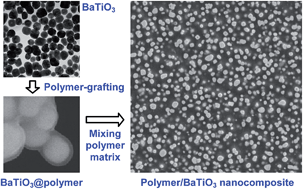An ideal nanostructure of polymer/BaTiO3 dielectric materials with high reliability for breakdown strength: isolated and uniformly dispersed BaTiO3 nanoparticles by thick polymer shells
Abstract
Poly(methyl methacrylate)s (PMMAs) with various chain lengths were grafted onto barium titanate (BT) particles using surface-initiated polymerization. The obtained core–shell particles were blended with additional PMMA to yield nanocomposites where the BT particles could not approach each other due to the PMMA shells (PMMA-BT). It was confirmed that the BT particles were uniformly dispersed in PMMA-BT by SEM observation. Reliability of the dielectric properties of PMMA-BT was evaluated under an alternating current electric field at 50 Hz using 16 specimens, and compared to that of conventional nanocomposites prepared by blending PMMA with the unmodified BT nanoparticles. The homogeneous distribution of the BT particles for PMMA-BT had no great influence on the reliability of complex relative permittivity while it improved the reliability for the dielectric breakdown strength EDB. The superior reliability for the EDB of PMMA-BT would result from the absence of percolation of the BT particles in the PMMA-BT system. This finding demonstrates that the nanostructure where the BT particles are isolated and uniformly dispersed by polymer shells is ideal for high EDB reliability.


 Please wait while we load your content...
Please wait while we load your content...